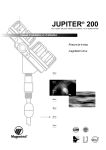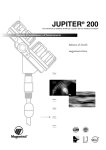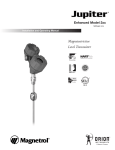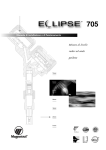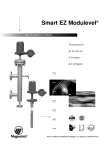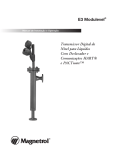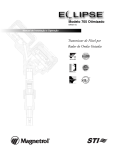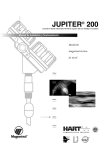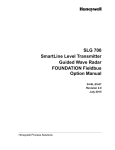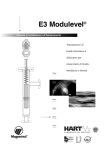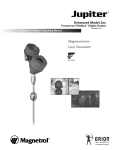Download Magnetrol 2xx Instruction manual
Transcript
JUPITER 200 ® Refer to bulletin 46-649 for Jupiter® 200 with Fieldbus Foundation Installation and Operating Manual Magnetostrictive Level Measurement 7xxx 6xxx 5xxx 4xxx 3xxx 2xxx 1xxx I VE GOT ABILITY ® FE T Y I EGRITY NT SA VE L LE UNPACKING Unpack the instrument carefully. Make sure all components have been removed from the foam protection. Inspect all components for damage. Report any concealed damage to the carrier within 24 hours. Check the contents of the carton/crates against the packing slip and report any discrepancies to Magnetrol. Check the nameplate model number (Model number/approvals as per inserted separate sheet) to be sure it agrees with the packing slip and purchase order. Check and record the serial number for future reference when ordering parts. Amplifier nameplate: - partnumber - amplifier - serial n° - temperature/pressure - approval data These units are in conformity with the provisions of: 1. The EMC Directive: 89/336/EEC. 0038 The units have been tested to EN 0344 61000-6-4/2001 and EN 61000-62/2001. 2. Directive 94/9/EC for Equipment or protective system for use in potentially explosive atmospheres. EC-type examination certificate number ISSEP06ATEX024X (intrinsic safe units) or ISSEP06ATEX010 (EEx d units). 3. The PED directive 97/23/EC (pressure equipment directive). Safety accessories per category IV module H1. MOUNTING External Mount Model Note: if ordered from the factory with the Magnetic Level Indicator the transmitter will be attached to the gauge and configured for the application. Strap CAUTION: do not rotate the housing. This may cause damage to the sensor cables. Guide Tab Direct Insertion Model Up min 2" Bottom view Float attachment detail 2 WIRING CAUTION: power must be switched OFF before wiring the unit. – – LOOP CURRENT Positive supply to (+) terminal/HART connection Negative supply to (-) terminal/HART connection min 12 V DC – max 28,4 V DC (Exi) - 32 V DC (Exd) + ® IS IS Shield wire to green grounding screw (resistance to ground must be < 1 Ω). Use certified flameproof cable gland(s) and cable for Explosion proof area. 100 % 0% Customer supplied local current meter Ex Ex Ex Non Ex Non Ex Non Ex Galvanic Barrier: Intrinsically safe units: max 28,4 V DC @ 94 mA Not needed for General Purpose / explosion proof models. ANALOG I/O or DIGITAL I/O (only for units with HART) Do not connect shield IMPORTANT: The shield wire should only be grounded at ONE side only. It is recommended to connect the shield to ground in the field (at the transmitter side - as shown above) but connecting in the control room is also allowed. LOOP RESISTANCE 1200 20.5 mA 1000 800 Ω 620 600 400 200 24 VDC 0 11 0 10 20 30 40 VDC 3 CONFIGURATION NOTE: When connected to an approved barrier, the intrinsically safe electronics of the Jupiter® 200 allow to remove the covers with power switched on – even if the area is known to be hazardous 2 line – 8 characters LCD Default display cycles every 8 s through Status «STATUS» / Level «LEVEL» / % output «% OUTPUT» / Loop «LOOP». Level not displayd for FF units. Up/Down and Enter pushbuttons Display Comment : The last character on the first line of the display changes to «!». This sign confirms that the values/choices of the second line can be modified via the and push buttons. Units! cm Press Units! cm Press * Scroll through the choices or increase/decrease the values on the second line of the display by and pushbuttons. pushbutton. * Accept values/choices as selected by Units cm Press Scroll through the menu. PASSWORD ACTION/ COMMENT/ Ent Pass 0 Display shows «0» Factory default setting Data is not protected Ent Pass! 1 Press and last character changes into «!» Enter your personal password with and (any value between 1 and 255) Press to confirm Setting password Press and enter old password and last character changes into «!» Press Enter your new password with and (any value between 1 and 255) Press to confirm Changing password Display shows an encrypted value, enter your password or call Magnetrol for assistance to recoop your password if necessary Data is protected by a valid Password DISPLAY New Pass 4096 NOTE: Password protection is activated when after 5 minutes no keystrokes are sensed. 4 CONFIGURATION TERMINOLOGY 20 mA Level (100%-point) Float 1 Level Offset = cm or inches The offset is the distance between reference point (e.g. bottom of tank) and end of probe. From the reference point both 4 mA and 20 mA levels are calibrated. When offset is set at zero, the end of the probe is the reference point. 4 mA Level = cm or inches or zero level point, is measured from the reference point. The unit with SIL enhanced electronics has a diagnostic zone at the bottom of the probe. Float 2 Probe Length Probe Length 20 mA Level = cm or inches or 100 % level point, is measured from the reference point. 4 mA Level (0%-point) Float 1 Float 2 cm or inches, record the exact probe length as Probe length = printed on the nameplate: 2xx-xxx-xxM-xxx Level offset Reference point No offset (Offset at 0 cm) 100 % 20 mA = 75 cm 0% 4 mA = 15 cm Positive offset (Offset at 10 cm) Negative offset (Offset at -15 cm) 20 mA = 85 cm 20 mA = 60 cm 4 mA = 25 cm 4 mA = 0 cm 75 cm 15 cm 10 cm BEFORE STARTING Start from run mode: 1. Select the desired language for configuration: English or Spanish in the language screen (22 or 25) «language». Scroll up for quickly reaching the language selection screen. 2. Define type of measurement: a. Level only (pages 6 & 7) b. Interface only (pages 8 & 9) (pages 10 & 11) c. Interface and Level d. Level and Interface (pages 11 & 12) Scroll down until the screen reads «MeasType». The unit will now show only the applicable screens for the selected type of measurement. 3. Scroll one screen down and select the applicable engineering unit in «Units», all configuration values will be entered in that engineering unit. 4. Refer to the configuration procedure of the selected type of measurement. 5. Refer to page 14 for all hidden diagnostic screens. These screens allow the advanced user to configure the unit for special applications or to troubleshoot the unit in the field. It is NOT recommended to access this toolset without proper guidance or having followed proper training. 5 MENU: STEP BY STEP PROCEDURE – Jupiter 200: Level only – Loop signal (PV) is Level Configuration Run mode Screen Action 1 *Status* *Level* *%Output* *Loop* Transmitter Display Transmitter default values cycle every 8 seconds. Status «Status», Volume «Volume», % Output «% Output», and Loop «Loop». 2 Level xxx.xx Transmitter Display Transmitter displays Level Value in selected engineering units. 3 %Output xx.xx Transmitter Display Transmitter displays % Output measurement derived from 20 mA span. 4 Loop xx.xx mA Transmitter Display Transmitter displays Loop measurement (mA). 5 MeasType (select) Select the type of measurement Select level «Lvl only». 6 Units (select) Select units for level cm «cm» or inches «inches». 7 Probe Ln xxx.xx Enter the exact length of probe Enter as per the 3 last digits of the probe partnumber on the nameplate: From 15 cm up to 999 cm e.g. 242-D111-AAM-280, enter «280» cm probe length. 8 Set 4mA xxx.xx Enter the PV for 4 mA Enter 4 mA level point, measured from reference point in selected level units. 9 Set 20mA xxx.xx Enter the PV for 20 mA Enter 20 mA level point, measured from reference point in selected level units. 10 Lvl Ofst xxx.xx Enter the offset value When entering configuration values from the end of the probe is cumbersome, an offset can be introduced to determine a new reference point. This reference point can be either below the probe (positive offset) or at the probe (negative offset). See page 5 “Terminology”. 11 Damping xx.x s Enter the damping factor. A Damping factor (1-25 seconds) may be added to smooth a noisy display and/or output due to turbulence. Below 15 s = 0,1 s increments. Above 15 s = 1 s increments. 12 Fault (Select) Enter the value for error. Select «3.6 mA», «22 mA» or hold last value «HOLD». In case of loop failure, error signal will follow the failing trend; meaning the unit will show 3.6 mA when the reviewed loop current by the device is found too low. The unit will show 22 mA in case the reviewed loop current is found too high. 13 Poll Adr xx Enter HART ID number. Select a HART poll address (0-15). Enter 0 for a single transmitter installation. = Quick Start up 6 Comment MENU: STEP BY STEP PROCEDURE – Jupiter 200: Level only Diagnostics Screen Action Comment 14 Trim 4 xxxx Fine tune the 4 mA point. Attach a mA meter to the output. If the output does not equal 4.0 mA, adjust the value on the display to equal 4.00 mA. 15 Trim 20 xxxx Fine tune the 20 mA point. Attach a mA meter to the output. If the output does not equal 20.0 mA, adjust the value on the display to equal 20.00 mA. 16 Loop Tst xx.x mA Enter a mA output value. Set mA Output to any given value to perform loop test. 17 Deadband xx.x None, do not adjust. Factory setting. 18 Snsr Mnt (select) Select the type of mounting. «MLI Top» External mount Jupiter – Top mounted Jupiter «MLI Bot» External mount Jupiter – Bottom mounted Jupiter «Dir Near» Direct mount Jupiter – NPT, BSP and Flanged ≤ 600 lbs / PN160 «Dir Ext» Direct mount Jupiter – Flanged ≥ 900 lbs / PN250 19 Trim Lvl xx.xx Enter value to adjust level reading. Allows to compensate for a fixed level deviation. 20 F1 Cnts xxxx Diagnostic display. Shows time of flight from the start pulse to reflected signal from level. 21 New Pass xxx Enter new password. Use arrows to select desired value. Values between 0 and 255. 22 Language (select) Select language Select «English» or «Espagnol». 23 JupiterHT Ver 3.0A None, do not adjust. Factory setting. «Ver» refers to software version. 24 DispFact (select) Advanced diagnostics. See page 14. 7 MENU: STEP BY STEP PROCEDURE – Jupiter 200: Interface only – Loop signal (PV) is Interface Level Configuration Run mode Screen Action 1 *Status* *IfcLevel* *%Output* *Loop* Transmitter Display Transmitter default values cycle every 8 seconds. Status «Status», Volume «Volume», % Output «% Output», and Loop «Loop». 2 IfcLevel xxx.xx Transmitter Display Transmitter displays Interface Value in selected engineering units. 3 %Output xx.xx Transmitter Display Transmitter displays % Output measurement derived from 20 mA span. 4 Loop xx.xxx mA Transmitter Display Transmitter displays Loop measurement (mA). 5 MeasType (select) Select the type of measurement Select Interface «Ifc only». 6 Units (select) Select units for level cm «cm» or inches «inches». 7 Probe Ln xxx.xx Enter the exact length of probe Enter as per the 3 last digits of the probe partnumber on the nameplate: From 15 cm up to 999 cm e.g. 242-D111-AAM-280, enter «280» cm probe length. 8 Set 4mA xxx.xx Enter the PV for 4 mA Enter 4 mA level point, measured from reference point in selected level units. 9 Set 20mA xxx.xx Enter the PV for 20 mA Enter 20 mA level point, measured from reference point in selected level units. 10 Lvl Ofst xxx.xx Enter the offset value When entering configuration values from the end of the probe is cumbersome, an offset can be introduced to determine a new reference point. This reference point can be either below the probe (positive offset) or at the probe (negative offset). See page 5 “Terminology”. 11 Damping xx.x s Enter the damping factor. A Damping factor (1-25 seconds) may be added to smooth a noisy display and/or output due to turbulence. Below 15 s = 0,1 s increments. Above 15 s = 1 s increments. 12 Fault (Select) Enter the value for error. Select «3.6 mA», «22 mA» or hold last value «HOLD». In case of loop failure, error signal will follow the failing trend; meaning the unit will show 3.6 mA when the reviewed loop current by the device is found too low. The unit will show 22 mA in case the reviewed loop current is found too high. 13 Poll Adr xx Enter HART ID number. Select a HART poll address (0-15). Enter 0 for a single transmitter installation. = Quick Start up 8 Comment MENU: STEP BY STEP PROCEDURE – Jupiter 200: Interface only – Loop signal (PV) is Interface Level Diagnostics Screen Action Comment 14 Trim 4 xxxx Fine tune the 4 mA point. Attach a mA meter to the output. If the output does not equal 4.0 mA, adjust the value on the display to equal 4.00 mA. 15 Trim 20 xxxx Fine tune the 20 mA point. Attach a mA meter to the output. If the output does not equal 20.0 mA, adjust the value on the display to equal 20.00 mA. 16 Loop Tst xx.x mA Enter a mA output value. Set mA Output to any given value to perform loop test. 17 Deadband xx.x None, do not adjust. Factory setting. 18 Snsr Mnt (select) Select the type of mounting. «MLI Top» External mount Jupiter – Top mounted Jupiter «MLI Bot» External mount Jupiter – Bottom mounted Jupiter «Dir Near» Direct mount Jupiter – NPT, BSP and Flanged ≤ 600 lbs / PN160 «Dir Ext» Direct mount Jupiter – Flanged ≥ 900 lbs / PN250 19 Trim Ifc xx.xx Enter value to adjust interface reading. Allows to compensate for a fixed level deviation. 20 F1 Cnts xxxx Diagnostic display. Shows time of flight from the start pulse to reflected signal from level. 21 New Pass xxx Enter new password. Use arrows to select desired value. Values between 0 and 255. 22 Language (select) Select language Select «English» or «Espagnol». 23 JupiterHT Ver 3.0A None, do not adjust. Factory setting. «Ver» refers to software version. 24 DispFact (select) Advanced diagnostics. See page 14. 9 MENU: STEP BY STEP PROCEDURE – Jupiter 200: Interface and Level – Loop signal (PV) is Interface Level Configuration Run mode Screen Action 1 *Status* *Level* *%Output* *Loop* Transmitter Display Transmitter default values cycle every 8 seconds. Status «Status», Volume «Volume», % Output «% Output», and Loop «Loop». 2 IfcLevel xxx.xx Transmitter Display Transmitter displays Interface Level Value in selected engineering units. 3 %Output xx.xx Transmitter Display Transmitter displays % Output measurement derived from 20 mA span. 4 Loop xx.xx mA Transmitter Display Transmitter displays Loop measurement (mA). 5 Level xxx.xxx Transmitter Display Unit displays locally top liquid level. 6 MeasType (select) Select the type of measurement Select Interface and level «Ifc&Lvl». 7 Units (select) Select units for level cm «cm» or inches «inches». 8 Probe Ln xxx.xx Enter the exact length of probe Enter as per the 3 last digits of the probe partnumber on the nameplate: From 15 cm up to 999 cm e.g. 242-D111-AAM-280, enter «280» cm probe length. 9 Set 4mA xxx.xx Enter the PV for 4 mA Enter 4 mA level point, measured from reference point in selected level units. 10 Set 20mA xxx.xx Enter the PV for 20 mA Enter 20 mA level point, measured from reference point in selected level units. 11 Lvl Ofst xxx.xx Enter the offset value When entering configuration values from the end of the probe is cumbersome, an offset can be introduced to determine a new reference point. This reference point can be either below the probe (positive offset) or at the probe (negative offset). See page 5 “Terminology”. 12 Damping xx.x s Enter the damping factor. A Damping factor (1-25 seconds) may be added to smooth a noisy display and/or output due to turbulence. Below 15 s = 0,1 s increments. Above 15 s = 1 s increments. 13 Fault (Select) Enter the value for error. Select «3.6 mA», «22 mA» or hold last value «HOLD». In case of loop failure, error signal will follow the failing trend; meaning the unit will show 3.6 mA when the reviewed loop current by the device is found too low. The unit will show 22 mA in case the reviewed loop current is found too high. 14 Poll Adr xx Enter HART ID number. Select a HART poll address (0-15). Enter 0 for a single transmitter installation. = Quick Start up 10 Comment MENU: STEP BY STEP PROCEDURE – Jupiter 200: Interface and Level – Loop signal (PV) is Interface Level Diagnostics Screen Action Comment 15 Trim 4 xxxx Fine tune the 4 mA point. Attach a mA meter to the output. If the output does not equal 4.0 mA, adjust the value on the display to equal 4.00 mA. 16 Trim 20 xxxx Fine tune the 20 mA point. Attach a mA meter to the output. If the output does not equal 20.0 mA, adjust the value on the display to equal 20.00 mA. 17 Loop Tst xx.x mA Enter a mA output value. Set mA Output to any given value to perform loop test. 18 Deadband xx.x None, do not adjust. Factory setting. 19 Snsr Mnt (select) Select the type of mounting. «MLI Top» External mount Jupiter – Top mounted Jupiter «MLI Bot» External mount Jupiter – Bottom mounted Jupiter «Dir Near» Direct mount Jupiter – NPT, BSP and Flanged ≤ 600 lbs / PN160 «Dir Ext» Direct mount Jupiter – Flanged ≥ 900 lbs / PN250 20 Trim Lvl xx.xx Enter value to adjust level reading. Allows to compensate for a fixed level deviation. 21 Trim Ifc xx.xx Enter value to adjust interface reading. Allows to compensate for a fixed level deviation. 22 F1 Cnts xxxx Diagnostic display float 1 (see terminology page 5). Shows time of flight from the start pulse to reflected signal from float 1. 23 F2 Cnts xxxx Diagnostic display float 2 (see terminology page 5). Shows time of flight from the start pulse to reflected signal from float 2. 24 New Pass xxx Enter new password. Use arrows to select desired value. Values between 0 and 255. 25 Language (select) Select language Select «English» or «Espagnol». 26 JupiterHT Ver 3.0A None, do not adjust. Factory setting. «Ver» refers to software version. 27 DispFact (select) Advanced diagnostics. See page 14. 11 MENU: STEP BY STEP PROCEDURE – Jupiter 200: Level and Interface – Loop signal (PV) is top liquid level Configuration Run mode Screen Action 1 *Status* *Level* *%Output* *Loop* Transmitter Display Transmitter default values cycle every 8 seconds. Status «Status», Volume «Volume», % Output «% Output», and Loop «Loop». 2 Level xxx.xx Transmitter Display Transmitter displays top liquid value in selected engineering units. 3 %Output xx.xx Transmitter Display Transmitter displays % Output measurement derived from 20 mA span. 4 Loop xx.xx mA Transmitter Display Transmitter displays Loop measurement (mA). 5 IfcLevel xxx.xxx Transmitter Display Unit displays locally interface level. 6 MeasType (select) Select the type of measurement Select Level and Interface «Lvl&Ifc». 7 Units (select) Select units for level cm «cm» or inches «inches». 8 Probe Ln xxx.xx Enter the exact length of probe Enter as per the 3 last digits of the probe partnumber on the nameplate: From 15 cm up to 999 cm e.g. 242-D111-AAM-280, enter «280» cm probe length. 9 Set 4mA xxx.xx Enter the PV for 4 mA Enter 4 mA level point, measured from reference point in selected level units. 10 Set 20mA xxx.xx Enter the PV for 20 mA Enter 20 mA level point, measured from reference point in selected level units. 11 Lvl Ofst xxx.xx Enter the offset value When entering configuration values from the end of the probe is cumbersome, an offset can be introduced to determine a new reference point. This reference point can be either below the probe (positive offset) or at the probe (negative offset). See page 5 “Terminology”. 12 Damping xx.x s Enter the damping factor. A Damping factor (1-25 seconds) may be added to smooth a noisy display and/or output due to turbulence. Below 15 s = 0,1 s increments. Above 15 s = 1 s increments. 13 Fault (Select) Enter the value for error. Select «3.6 mA», «22 mA» or hold last value «HOLD». In case of loop failure, error signal will follow the failing trend; meaning the unit will show 3.6 mA when the reviewed loop current by the device is found too low. The unit will show 22 mA in case the reviewed loop current is found too high. 14 Poll Adr xx Enter HART ID number. Select a HART poll address (0-15). Enter 0 for a single transmitter installation. = Quick Start up 12 Comment MENU: STEP BY STEP PROCEDURE – Jupiter 200: Level and Interface – Loop signal (PV) is top liquid level Diagnostics Screen Action Comment 15 Trim 4 xxxx Fine tune the 4 mA point. Attach a mA meter to the output. If the output does not equal 4.0 mA, adjust the value on the display to equal 4.00 mA. 16 Trim 20 xxxx Fine tune the 20 mA point. Attach a mA meter to the output. If the output does not equal 20.0 mA, adjust the value on the display to equal 20.00 mA. 17 Loop Tst xx.x mA Enter a mA output value. Set mA Output to any given value to perform loop test. 18 Deadband xx.x None, do not adjust. Factory setting. 19 Snsr Mnt (select) Select the type of mounting. «MLI Top» External mount Jupiter – Top mounted Jupiter «MLI Bot» External mount Jupiter – Bottom mounted Jupiter «Dir Near» Direct mount Jupiter – NPT, BSP and Flanged ≤ 600 lbs / PN160 «Dir Ext» Direct mount Jupiter – Flanged ≥ 900 lbs / PN250 20 Trim Lvl xx.xx Enter value to adjust level reading. Allows to compensate for a fixed level deviation. 21 Trim Ifc xx.xx Enter value to adjust interface reading. Allows to compensate for a fixed level deviation. 22 F1 Cnts xxxx Diagnostic display float 1 (see terminology). Shows time of flight from the start pulse to reflected signal from float 1. 23 F2 Cnts xxxx Diagnostic display float 2 (see terminology). Shows time of flight from the start pulse to reflected signal from float 2. 24 New Pass xxx Enter new password. Use arrows to select desired value. Values between 0 and 255. 25 Language (select) Select language Select «English» or «Espagnol». 26 JupiterHT Ver 3.0A None, do not adjust. Factory setting. «Ver» refers to software version. 27 DispFact (select) Advanced diagnostics. See page 14. 13 MENU: STEP BY STEP PROCEDURE – Jupiter 200: ADVANCED CONFIGURATION Hidden diagnostic screens. Do not acces without assistance or having followed advanced training. Diagnostics Screen 14 Action Comment Review factory parameters Select «YES» to reveal Factory parameters; «NO» to hide. Review Diagnostic messages. A cumulative review of all diagnostic messages. Press the enter button twice to clear. Display mode. Shows time in hours that unit is in operation since last power on. Diagnostic display. Select «YES» to clear «History». Conv Fct xxxx None, do not adjust. Factory setting. 6 Scl Ofst xxx None, do not adjust. Factory setting. 7 F1Tresh None, do not adjust. Factory setting. 8 F1 Polar None, do not adjust. Factory setting. 9 F2Tresh None, do not adjust. Factory setting. 10 F2 Polar None, do not adjust. Factory setting. 11 Senstvty xxx Change cryptic value Enter a value upward or downward to sense the liquid surface. Allows to fine gain adjustment. 12 Drv Ampl xxx None, do not adjust. Factory setting. 13 Min Sep None, do not adjust. Factory setting. 14 ElecTemp xxx C None, do not adjust. Shows internal housing temperature. 15 Max Temp xxx C None, do not adjust. Diagnostic display, shows maximum internal housing temperature recorded. 16 Min Temp xxx C None, do not adjust. Diagnostic display, shows minimum internal housing temperature recorded. 1 DispFact Select 2 History (current status) 3 Run time Xx h 4 History Reset 5 PACTware – Configuration and Troubleshooting For more details about the use of PACTware and FDT, refer to instruction manual 59-601 WHAT IS FDT, PACTware AND DTM MOST COMMONLY USED SCREENS • FDT (Field Device Tool) is a new interface code that describes the standardization between frame programs (e.g., PACTware) and DTMs (Device Type Manager). • Online parameterization: allows the user to configure the unit online. • Offline parameterization: allows the user to configure the unit offline. • PACTware (Process Automation Configuration Tool) is a frame program. It is a device-independent software program that communicates with all approved DTMs. • Tank view: displays a common operating window graphically showing % output of level. • DTM (Device Type Manager) is not a stand-alone program but a device-specific software driver designed to operate within a frame program such as PACTware. It includes all special information needed to communicate with a specific device (e.g. Jupiter 200). There are two basic categories of DTMs—Communication (HART, Fieldbus®, Profibus®, etc.) and Field Device (e.g. Jupiter 200). • Waveform: shows the actual echocurve. The waveform is an extremely useful tool for advanced configuration and troubleshooting. • Process trend: all key data (Level, % Output, Loop) can be trended and saved, scales can be adapted. • Device/diagnosis: the diagnosis: the diagnosis screen allows examination of all faults, warnings and international messages. MINIMUM SYSTEM REQUIREMENTS Following are general requirements for proper operation of this program: TROUBLESHOOTING Pentium® II 500 MHz processor. 120 MB free hard disk space. This program offers a wealth of information critical to effective troubleshooting. If a problem should arise and factory assistance is necessary for analysis, be prepared to save and email the following files: Windows® XP/2000 (Service Pack 1) / NT 4.0 (Service Pack 6). • ONLINE PARAMETERS: the complete list of configuration data. Graphic Resolution 1024x768 (16-bit color). • PROCESS TREND information that includes the time of upset/error condition. 128 MB RAM. Internet Explorer 5.0. • WAVEFORM showing upset/error condition (when possible). RS232 serial interface. RS232-HART or USB-HART serial interface for point-topoint connection or RS232-RS485 converter for connection to Hart Multiplexer. • ERROR MONITOR (VIEW/ERROR MONITOR) including upset/error condition. HART communication DTM. Transmitter with current HART revision. CONNECTIONS The following diagram shows a typical hardware configuration. Observe all safety codes when attaching to instrument loops in hazardous areas or when measuring flammable media. Computers are not intrinsically safe devices. HART® key Power supply: GP / intrinsically safe / explosion proof: min 12 V DC 0% 100 % Galvanic Barrier: max: 28,4 V DC @ 94 mA for intrinsically safe units (not needed for GP and explosion proof models). Ex Non Ex 15 CONFIGURATION USING HART® CONNECTIONS - Connection of your Hart communicator: • at power terminals (+) and (-) in wiring compartment • at first junction box between unit and control room. + IMPORTANT: The digital HART® communication is superimposed on the 4-20 mA loop and requires a min. load resistance of 250 Ω and a max load resistance of 450 Ω. Junction CHECK HART® 250 Ω < RL < 450 Ω + Before starting the HART® configuration procedure – check if your HART® communicator is equipped with the proper Jupiter Device Descriptors (DD’s). I/O Select NO: Select 4: Select 5: Check manufacturer: Control Room Display Power Supply HCF Release Date July 2003 July 2006 Current Meter start up the communicator go offline utility simulation Magnetrol HART Version Dev V2 DD V1 Dev V3 DD V2 Compatible with software Version 2.0A ... 2.0B Version 3.0A and later When the proper software version is not found, consult your local HART® Service Center to load the correct Jupiter DD’s. HART MENU For easy PACTware set up, consult instruction manual 59-600 I/O Start up the device 1 Enter Device Set Up «DEVICE SET UP» Press one of the following alphanumeric keys (if no key is sensed after 8 s, the unit will automatically jump to RUN mode and alternatively show Level/% Output and Loop signal 1 for entering Calibration «CALIBRATION» (see page 11 for additional information) 2 for entering Basic Set Up «BASIC SET UP» – general HART 3 for Advanced Set Up «ADVANCED SET UP» (see page 11 for additional information) 4 for entering Diagnostics «DIAGNOSTICS» (see page 11 for additional information) 5 for entering Review «REVIEW» to review all settings. HART ERROR MESSAGES SIL1 SIL2 Description Warning HART Status Yes Yes Yes Cal Reqd Warning Yes Yes Yes Lo Temp Warning Yes Yes Yes Hi Temp Warning Yes Yes Yes Float 2 Fail Fault Yes Yes Yes Loop DAC trim values are defaults, loop output inaccurate Default calibration parameters in use, level reading inaccurate Present temperature in electronics compartment is below -40 °C Present temperature in electronics compartment is above +80 °C No level signal detected from Float 2 Float 1 Fail Fault Yes Yes Yes No level signal detected from Float 1 No Signal Fault Yes Yes Yes No level signal detected from any float LoopFail Fault Yes Yes Yes Loop current differs from the commanded value Snsr Brd Fail Fault Yes Yes Yes Invalid reading from the Analog Board DfltParm Fault Yes Yes Yes Non-volatile parameters have been defaulted 16 LCD Class TrimReqd CONFIGURATION USING HART® 1 2 3 4 5 Device Setup Level % Range Loop Device Variables 1 Calibration 1 Level 2 IfcLvl 2 Basic Setup 3 Advanced Setup 4 Diagnostics 1 2 3 4 5 6 7 8 9 10 11 12 13 14 Measurement Type Level Units Probe Length 4 mA Set Point 20 mA Set Point Level Offset Damping System Fault State Deadband Sensor Mount Trim Level Trim Ifc Level SV is Date/Time/Initials 1 2 3 4 5 6 Tag Descriptor Date Message Poll Address Final asmbly num 1 2 3 4 5 6 7 Trim Loop Current Enter Password Factory Settings Max Temperature Min Temperature 1 2 3 4 5 6 Loop Test Present Status Status History Float1 Counts Float2 Counts Elec Temperature Reset Temperatures New User Password 1 2 3 4 4 mA 20 mA Other End 1 Faults 2 Warnings 1 2 3 4 5 6 7 8 9 10 11 12 13 Orion S/N Device ID Conversion Factor Scale Offset Float1 Threshold Float1 Polarity Float2 Threshold Float2 Polarity Sensitivity Drive Amplitude Min Seperation Factory Param 1 Factory Param 2 1 View History 2 Reset History 5 Review 1 2 3 4 5 6 7 8 9 10 11 12 13 14 15 16 17 18 19 20 21 Model Manufacturer Orion S/N Firmware Version Coprocessor Version Tag Descriptor Date Message Poll Address Final asmbly num Device ID Measurement Type Level Units Probe Length 4mA Set Point 20mA Set Point Level Offset Damping System Fault State Deadband 22 23 24 25 26 27 28 29 30 31 32 33 34 35 36 37 38 39 40 41 Sensor Mount Trim Level Trim Ifc Level SV is Date/Time/Initials 4 mA Trim Value 20 mA Trim Value Conversion Factor Scale Offset Float1 Threshold Float1 Polarity Float2 Threshold Float2 Polarity Sensitivity Drive Amplitude Min Separation Universal rev Fld dev rev Software rev Num req preams 17 MAINTENANCE TROUBLESHOOTING Problem Transmitter does not track level Solution (External Mount) (Direct Insertion) Float inside the level gauge is moving slow or not at all. Remove transmitter from piping column and test with re-alignment magnet. Run magnet from bottom to top of probe. Check zero and span calibration. If no change in output, consult the factory. Float stuck, Probe bent (Chamber) Ensure that the magnetic level indicator is plumb. The process fluid being measured may be too viscous and heat tracing may be required to make the material more fluid. The specific gravity of the process fluid and float weight may need to be reverified. The liquid being measured may contain magnetic particles collecting on the magnetic section of the float causing drag. If this happens magnetic trap assemblies can be purchased from the factory. Visual inspection of the float may be required to see if the float has collapsed. LEVEL, % OUTPUT, and LOOP values are all inaccurate. Basic configuration data is questionable. Reconfigure probe length and offset. Ensure the level is accurate. Reconfigure loop values. LEVEL, % OUTPUT, and LOOP values fluctuate Turbulence, increase damping factor until readings stabilize. Level reading on display is correct, but loop value is stuck at 4 mA Set poll address to zero DISPLAY MALFUNCTION Ambient temp Symptom < -20 °C (-5 °F) Display may temporarily white out > +70 °C (+160 °F) Display may temporarily black out -20 °C up to +70 °C Display will recover without damage (-5 °F up to +160 °F) 18 MAINTENANCE ERROR MESSAGES Display Message Action Comment OK None Normal operating mode Initial None Program is Initializing, level reading held at 4 mA set point. This is a transient condition. NoSignal No level signal being detected. Make sure float is not damaged and within measuring range. Hi Temp Present temperature in electronics compartment is above +80° C 1) Transmitter may need to be moved to ensure ambient temperature is within specification Present temperature in electronics compartment is below -40° C. 1) Transmitter may need to be moved to ensure ambient temperature is within specification TrimReqd Factory set Loop values are defaults, loop output may be inaccurate Consult factory Cal Reqd Factory set default calibration parameters are in use, level reading may be inaccurate Consult factory LoopFail Loop current differs from expected value Consult factory Note: In case of loop failure, error signal will follow the failing trend; meaning the unit will show 3.6 mA when the reviewed loop current by the device is found too low. The unit will show 22 mA in case the reviewed loop current is found too high. DfltParm Internal non-volatile parameters Consult factory have been defaulted Float 2 Fail No level signal detected from float 2 Make sure 2 floats are being used, are not damaged, and within measuring range Float 1 Fail No level signal detected from float 1 Make sure float is not damaged, and within measuring range Snsr Brd Measurement board not responding Consult factory Lo Temp 2) Change to remote mount transmitter 2) Change to remote mount transmitter PACTware™ PC Program The JUPITER® 200 series offer the ability to do Trending and Waveform analysis using a PACTware DTM. This is a powerful troubleshooting tool that can aid in the resolution of some of the Error Messages shown above. Refer to Bulletins 59-101 and 59-601 for more information. Free of charge order code: 090-0059-200 (included in each order). 19 SAFETY INTEGRITY LEVELS 1 & 2 Jupiter® is the only magnetostrictive transmitter to achieve SIL 2 classification as 1oo1 device per IEC 61508. The below table offers the possibility to compare on a one-to-one basis, the SIL performance of Jupiter with other level transmitters. One-out-of-one device means the suggested SIL class by the manufacturer is achieved by a single transmitter. 1oo1: The use of 2 transmitters to achieve a higher SIL classification is often stated as 1oo2 (one out of two) devices. SFF: Safe Failure Fraction is the ratio between detected (safe and dangerous) and undetected (safe) instrument failures versus total failures by the instrument. The % of this ratio is preferably as high as possible. PFDavg: Average probability of failure on demand. This value is preferably as low as possible. For more complete information, ask for the Jupiter FMEDA report by Exida. Standard electronics SIL enhanced electronics SIL 1 as 1oo1 2 as 1oo1 Intrument Type B B SFF 83,7 % 90,7 % PFDavg 9,60E-04 5,45E-04 Fail Dangerous Undetected Fail Dangerous Detected Safe FITS Annual FITS Annual 218 1,91E-03 123 1,08E-03 698 6,11E-03 793 6,95E-03 421 3,69E-03 413 3,62E-03 Ask for our SIL manual 41-299 FLOAT FAILURE IDENTIFICATION The Jupiter® 200 with SIL enhanced electronics is either using a probe with inactive zone or an extended MLI cage to identify a sinking or collapsed float as a float failure. Jupiter® 200 with SIL enhanced electronics are equipped with one float for measuring either the top level or the interface level. Active span 4 - 20 mA Active span 4 - 20 mA Float failure zone 3,6 mA or 22 mA (selectable) Inactive zone (3,6 or 22 mA selectable) Direct insertion 20 MAD E IN USA External mount REPLACEMENT PARTS ➂ ➃ ➁ ➄ ➂ ➀ CAUTION: the electronic module connects to the guide tube via 3 connectors”. These connectors are brittle and require to be handled very careful. No. 1 Up 6 Part Number Electronic module Display and HART® Foundation Fieldbus 031-2839-001 031-2840-001 2 Terminal board General Purpose (GP, Exi and Exd) 3 4 “O”-Ring (Viton®) Housing cover without glass ➀ Housing cover with glass (GP/IS)➀ Housing cover with glass (XP)➀ 7 5 6 7 ➀ Description Float C-clips 030-9151-001 012-2201-237 004-9193-002 036-4410-001 036-4410-003 Consult factory 010-5140-001 For stainless steel housing covers – consult factory. 21 TRANSMITTER SPECIFICATIONS FUNCTIONAL/PHYSICAL Description Specification Power (at terminals) Power consumption General Purpose / ATEX Intrinsically Safe: 12 to 28,4 V DC ATEX Explosion Proof: 12 to 32 V DC 0,7 W Signal Output 4-20 mA with HART®, 3,8 mA to 20,5 mA useable (meets NAMUR NE 43) Probe Length 15 to 570 cm (6 to 224"). Consult factory for longer lengths Resolution Analog: 0,01 mA Display: 0,1 units Loop Resistance (see table below) 620 Ω @ 20,5 mA - 24 V DC Damping Adjustable 0-25 s Diagnostic Alarm Selectable 3,6 mA, 22 mA or hold User Interface HART® communicator, AMS® or PACTware® and/or 3-button keypad Display 2-line x 8-character LCD. Displays level (cm/inches), mA and % of level. Menu Language English and Spanish Housing Material IP 66/Aluminium A356T6 (< 0.20 % copper) or stainless steel Approvals ATEX II 1 G EEx ia IIC T4, intrinsically safe ATEX II 1 / 2 G EEx d IIC T6, explosion proof FM and CSA, Non incendive, intrinsically safe (FISCO) and explosion proof LRS – Lloyds Register of Shipping (marine applications) – pending GOST-K/GGTN-K – ROSTECH/FSTS – Russian Authorisation Standards – pending SIL (Safety Integrity Level) Standard electronics Enhanced electronics Electrical Data Functional safety to SIL 1 / SIL 2 in accordance to 61508 – SFF of 83,7 % – full FMEDA reports and declaration sheets available at request Functional safety to SIL 2 / SIL 3 in accordance to 61508 – SFF of 90,7 % – full FMEDA reports and declaration sheets available at request Ui = 28,4 V, li = 94 mA, Pi = 0,67 W Ui = 17,5 V, li = 380 mA, Pi = 5,32 W (Foundation Fieldbus) Equivalent Data Ci = 2,2 nF, Li = 3 µH Ci = 0,71 nF, Li = 3 µH (Foundation Fieldbus) Environmental protection EN 60654-1 Drop protection EN 50178 Surging protection Net and Gross Weight EN 61326 (1000V) Cast aluminium Stainless steel 2,70 kg net; 3,20 kg gross – amplifier only 5,70 kg net; 6,20 kg gross – amplifier only POWER CONSUMPTION 1200 20.5 mA 1000 800 Ω 620 600 400 200 24 VDC 0 11 0 22 10 20 30 40 VDC TRANSMITTER SPECIFICATIONS PERFORMANCE Description Specification Accuracy ± 0,4 mm (0.015") Repeatability ± 0,005 % of full span or 0,13 mm (0.005") – whichever is greater Linearity ± 0,020 % of full span or 0,79 mm (0.031") – whichever is greater Max fill / drain rate 9 m/min (30 ft/min) Response Time < 0,1 second Warm-up Time < 5 seconds Ambient Temp. -20 °C to +70 °C (-5 °F to +160 °F) Humidity 0-99 %, non-condensing Electromagnetic Compatibility Meets CE requirements (EN-61000-6-4, EN 61000-6-2) PROBE SPECIFICATIONS Description Materials Specification Probe Float 316/316L (1.4401/1.4404) standard or electropolished finish Hastelloy C® (2.4819) or Monel® (2.4360) 316 (1.4401), 316L (1.4404), Titanium or Hastelloy C® (2.4819) Process seal None, welded construction Probe diameter 16 mm (0.63") Float diameter (for direct insertion models only) Probe length Min 47 mm (1.85") – max 65 mm (2.55") see partnumber on page 7 Min 15 cm (6") – max 570 cm (224") selectable per 1 cm increments Dead band 316 and 316L Titanium Direct insertion model: 50 mm (2"). External mount model: depending configuration. 50 mm (2") – for units with standard electronics and single float 152 mm (6") – for units with standard electronics and dual floats 127 mm (5") – for units with SIL enhanced electronics -40 °C to +95 °C (-40 °F to +200 °F) – standard probe -40 °C to +260 °C (-40 °F to +500 °F) – high temperature probe -40 °C to +120 °C (-40 °F to +250 °F) – standard -196 °C to +455 °C (-320 °F to +850 °F) – with factory insulated MLI Max 22,8 bar @ +40 °C (330 psig @ 100 °F) Max 26,2 bar @ +40 °C (380 psig @ 100 °F) Hastelloy C Max 18,6 bar @ +40 °C (270 psig @ 100 °F) Upper Bottom Inactive zone - bottom Process Direct insertion temperature External mount Process Pressure➀ Vacuum service Full vacuum ➀ Consult factory for higher pressure (custom float). MODEL IDENTIFICATION A complete measuring system consists of: 1. Jupiter 200: transmitter and probe (MLI or cages as shown in this bulletin are not included). 2. OPTION: secondary float for interface applications (specify S.G. for lower liquid). 3. OPTION: ATLAS®. Magnetic level indicator for use with Jupiter 200, external mount model. Consult bulletin 46-138. 4. Free of charge: Magnetrol master C.D. with Jupiter 200 DTM (PACTware®). Order code: 090-BE59-200 (included in each order). 23 DIMENSIONS in mm (inches) 45° View 330 (13.00) 214 (8.43) 330 (13.00) 126 (4.94) Dead band 50 (2) Dead band 50 (2) 111 (4.38) Primary float For total or interface level (specified in model code) Jupiter Housing, (45° View) Active span Active span Probe length Probe length Secondary float For total level and interface level (consult factory for ordering) 83 (3.28) One float for total or interface level (specified in model code) 105 (4.12) 102 (4.00) 330 (13.00) Dead band Single float: 50 (2.00) Dual floats: 152 (6.00) 45° 127 (5.00) Inactive zone Ø 16 (0.63) 2 cable entries Ø 16 (0.63) Standard electronics Jupiter Housing SIL enhanced electronics PRESSURE/TEMPERATURE 40 316/316L SS 35 Hastelloy C 276 Process Pressure (bar) 30 Titanium CP2 25 20 15 10 5 0 0 50 100 150 Process Temperature (°C) 24 200 250 MODEL IDENTIFICATION BASIC MODEL NUMBER 1 Code for direct insertion Jupiter® 200 2 4 2 6 2 7 Magnetostrictive transmitter with standard HART® electronics Magnetostrictive transmitter with SIL enhanced HART® electronics Magnetostrictive transmitter with standard HART® electronics for level or interface for level or interface for level and interface➀ ➀ Level and interface requires 2 floats, order second float separately (see FLOAT selection below) APPROVALS AND HOUSING 3/4" NPT 1 3 A C E G M20 x 1,5 2 4 B D F H Cable entry (2 entries - one plugged) General purpose (& I.S. - XP FM/CSA) General purpose (& I.S. - XP FM/CSA) ATEX II 1/2G EEx d IIC T6, explosion proof ATEX II 1/2G EEx d IIC T6, explosion proof ATEX II 1G EEx ia IIC T4, intrinsically safe ATEX II 1G EEx ia IIC T4, intrinsically safe Cast aluminium housing Stainless steel housing Cast aluminium housing Stainless steel housing Cast aluminium housing Stainless steel housing MATERIALS OF CONSTRUCTION D D D D D 1 2 3 5 7 Standard temperature 316/316L (1.4401/1.4404) Hastelloy C (2.4819) Monel (2.4360) Electropolished 316/316L (1.4401/1.4404) High temperature 316/316L (1.4401/1.4404) max max max max max +95 °C (+200 °F) +95 °C (+200 °F) +95 °C (+200 °F) +95 °C (+200 °F) +260 °C (+500 °F) MOUNTING CONNECTION - SIZE/TYPE (consult factory for other process connections) Threaded 2 2 1" BSP (G1) thread 1 1 3/4" NPT thread ANSI flanges 5 3 3" 5 4 3" 6 3 4" 6 4 4" EN/DIN flanges 150 300 150 300 lbs. lbs. lbs. lbs. ANSI ANSI ANSI ANSI RF RF RF RF E E F F A B A B DN DN DN DN 80, 80, 100, 100, PN PN PN PN 16 25/40 16 25/40 EN EN EN EN 1092-1 1092-1 1092-1 1092-1 Type Type Type Type A A A A FLOAT (for models with 2 floats, consult factory for the lower float) Code AAM CAM ABM BAM CBM ACM BBM MAM NAM PAM MBM NBM PBM 00M Max operating pressure in bar (psig) 40 °C 95 °C 175 °C 260 °C (100 °F) (200 °F) (350 °F) (500 °F) For level only 22,8 (330) 21,0 (305) 18,6 (270) 16,6 (240) 0,84 18,6 (270) 17,6 (255) 16,2 (235) 14,8 (215) 22,8 (330) 21,0 (305) 18,6 (270) 16,6 (240) 0,70 26,2 (380) 23,8 (345) 16,2 (235) 11,4 (165) 18,6 (270) 17,6 (255) 16,2 (235) 14,8 (215) 0,64 22,8 (330) 21,0 (305) 18,6 (270) 16,6 (240) 0,52 26,2 (380) 23,8 (345) 16,2 (235) 11,4 (165) For interface only 22,8 (330) 21,0 (305) 18,6 (270) 16,6 (240) 0,89 / 26,2 (380) 23,8 (345) 16,2 (235) 11,4 (165) 1,00➀ 18,6 (270) 17,6 (255) 16,2 (235) 14,8 (215) 22,8 (330) 21,0 (305) 18,6 (270) 16,6 (240) 1,00 / 26,2 (380) 23,8 (345) 16,2 (235) 11,4 (165) 1,12➀ 18,6 (270) 17,6 (255) 16,2 (235) 14,8 (215) Custom float consult factory Min S.G. float material Ø x length in mm (inches) 316/316L 50 x 70 (2 x 2.75) Hastelloy C 47 x 76 (1.85 x 3) 316/316L 58,5 x 76 (2.30 x 3) Titanium 50 x 70 (2 x 2.75) Hastelloy C 58,5 x 76 (2.30 x 3) 316/316L 65 x 76 (2.55 x 3) Titanium 58,5 x 76 (2.30 x 3) 316/316L Titanium Hastelloy C 316/316L Titanium Hastelloy C consult factory consult factory consult factory consult factory consult factory consult factory ➀ Density in which the float sinks / Density in which the float floats. PROBE LENGTH (specify in cm increments) 0 1 5 5 7 0 min 15 cm (6") max 570 cm (224") Refer to dimensions on the left page for proper probe length specification). 2 D M complete code for JUPITER® 200: direct insertion model 25 DIMENSIONS in mm (inches) 102 (4) 76 (3) Probe Length Active Span Probe Length 76 (3) Active Span 76 (3) External mount Top mount with offset External mount Top mount 305 (12) 76 (3) 76 (3) Probe Length Active Span Probe Length Active Span Probe Length Active Span 76 (3) 76 (3) 305 (12) External mount Bottom mount with offset 26 External mount Bottom mount - high temp. External mount Top mount - high temp. MODEL IDENTIFICATION 1 Code for external mount Jupiter® 200 BASIC MODEL NUMBER 2 4 2 6 2 7 Magnetostrictive transmitter with standard HART® electronics Magnetostrictive transmitter with SIL enhanced HART® electronics Magnetostrictive transmitter with standard HART® electronics for level or interface for level or interface for level and interface➀ ➀ Level and interface requires 2 floats, consult factory for MLI APPROVALS AND HOUSING (consult factory for FM/CSA approvals) 3/4" NPT 1 3 A C E G M20 x 1,5 2 4 B D F H Cable entry (2 entries - one plugged) General purpose (& I.S. - XP FM/CSA) General purpose (& I.S. - XP FM/CSA) ATEX II 1/2G EEx d IIC T6, explosion proof ATEX II 1/2G EEx d IIC T6, explosion proof ATEX II 1G EEx ia IIC T4, intrinsically safe ATEX II 1G EEx ia IIC T4, intrinsically safe Cast aluminium housing Stainless steel housing Cast aluminium housing Stainless steel housing Cast aluminium housing Stainless steel housing MATERIALS OF CONSTRUCTION E F H G J 1 1 1 7 7 Top mount construction - 316/316L (1.4401/1.4404) Top mount offset construction - 316/316L (1.4401/1.4404) Bottom mount offset construction - 316/316L (1.4401/1.4404) Top mount HT offset construction - 316/316L (1.4401/1.4404) Bottom mount HT offset construction - 316/316L (1.4401/1.4404) max +120 °C (+250 °F) max +120 °C (+250 °F) max +120 °C (+250 °F) max +455 °C (+850 °F)➀ max +455 °C (+850 °F)➀ ➀ With factory insulated MLI. MOUNTING CONNECTION 0 0 0 0 M External mount Jupiter PROBE LENGTH (specify in cm increments) 0 1 5 5 7 0 min 15 cm (6") max 570 cm (224") Refer to dimensions on the left page for proper probe length specification. 2 0 0 0 0 M complete code for JUPITER® 200: external mount model NOTE: Magnetic Level Indicator (MLI) as shown on page 28 is not included in this partnumber. For MLI ordering information, consult sales bulletin 46-138 27 DIMENSIONS in mm (inches) 203 (8.00) 292 (11.50) 279 (11.00) 203 (8.00) 318 (12.50) Active Span Active Span Active Span MAD E IN USA MAD E IN USA MAD E IN USA Top mount Top mount offset Top mount offset High Temperature Bend Active Span Active Span Active Span 292 (11.50) 279 (11.00) 318 (12.50) 203 (8.00) MAD E IN USA MAD E IN USA MAD E IN USA Bottom mount offset 28 Bottom mount offset High Temperature Bend Bottom mount offset and secondary transmitter - Gemini ® JUPITER 200 Magnetostrictive Transmitter Configuration Data Sheet Copy blank page and store calibration data for future reference and troubleshooting. Item Vessel Name Vessel # Process Medium & S.G. Tag # Screen Serial # Probe Serial # Level Interface (optional) «Level» «IfcLvl» Sensor Mount Measurement Type Level Units Probe Length Level Offset «SnrMount» «MeasType» «Units» «Probe Ln» «Lvl Ofst» Sensitivity Loop Control 4mA point 20mA point Damping Fault Choice Threshold HART Poll Address Level Trim Trim 4 mA Trim 20 mA Deadband Trim 20 mA Float 1 Threshold Float 1 Polarity «Senstvty» Value Value TROUBLESHOOTING Working Value Non-Working Value «LoopCtrl» «Set 4mA» «Set 20mA» «Damping» «Fault» «Treshld» «Poll Adr» «Trim Lvl» «Trim 4» «Trim 20» «DeadBand» «Trim 20» «F1 Tresh» «F1 Polar» Float 2 Threshold «F2 Tresh» Float 2 Polarity «F2 Polar» «Drv Ampl» Drive Amplitude Minimum Separation «Min Sep» # of Counts «F1 Cnts» «F2 Cnts» Conversion Factor «Conv Fct» Electronics temperature «ElecTemp» Max temperature «Max Temp» Min temperature «Min Temp» Software Version New Password Name Date Time 29 30 31 IMPORTANT SERVICE POLICY Owners of Magnetrol products may request the return of a control; or, any part of a control for complete rebuilding or replacement. They will be rebuilt or replaced promptly. Magnetrol International will repair or replace the control, at no cost to the purchaser, (or owner) other than transportation cost if: a. Returned within the warranty period; and, b. The factory inspection finds the cause of the malfunction to be defective material or workmanship. If the trouble is the result of conditions beyond our control; or, is NOT covered by the warranty, there will be charges for labour and the parts required to rebuild or replace the equipment. In some cases, it may be expedient to ship replacement parts; or, in extreme cases a complete new control, to replace the original equipment before it is returned. If this is desired, notify the factory of both the model and serial numbers of the control to be replaced. In such cases, credit for the materials returned, will be determined on the basis of the applicability of our warranty. No claims for misapplication, labour, direct or consequential damage will be allowed. RETURNED MATERIAL PROCEDURE So that we may efficiently process any materials that are returned, it is essential that a “Return Material Authorisation” (RMA) form will be obtained from the factory. It is mandatory that this form will be attached to each material returned. This form is available through Magnetrol’s local representative or by contacting the factory. Please supply the following information: 1. 2. 3. 4. 5. 6. Purchaser Name Description of Material Serial Number and Ref Number Desired Action Reason for Return Process details All shipments returned to the factory must be by prepaid transportation. Magnetrol will not accept collect shipments. All replacements will be shipped FOB factory. BULLETIN N°: EFFECTIVE: SUPERSEDES: UNDER RESERVE OF MODIFICATIONS www.magnetrol.com ® BE 46-648.0 MARCH 2007 New BENELUX Heikensstraat 6, 9240 Zele, België Tel. +32 (0)52.45.11.11 • Fax. +32 (0)52.45.09.93 • E-Mail: [email protected] DEUTSCHLAND Alte Ziegelei 2-4, D-51491 Overath Tel. 02204 / 9536-0 • Fax. 02204 / 9536-53 • E-Mail: [email protected] FRANCE 40 - 42, rue Gabriel Péri, 95130 Le Plessis Bouchard Tél. 01.34.44.26.10 • Fax. 01.34.44.26.06 • E-Mail: [email protected] ITALIA Via Arese 12, I-20159 Milano Tel. (02) 607.22.98 (R.A.) • Fax. (02) 668.66.52 • E-Mail: [email protected] UNITED KINGDOM Unit 1 Regent Business Centre, Jubilee Road Burgess Hill West Sussex RH 15 9TL Tel. (01444) 871313 • Fax (01444) 871317 • E-Mail: [email protected] INDIA E-22, Anand Niketan, New Delhi - 110 021 Tel. 91 (11) 41661840 • Fax 91 (11) 41661843 • E-Mail: [email protected]
































